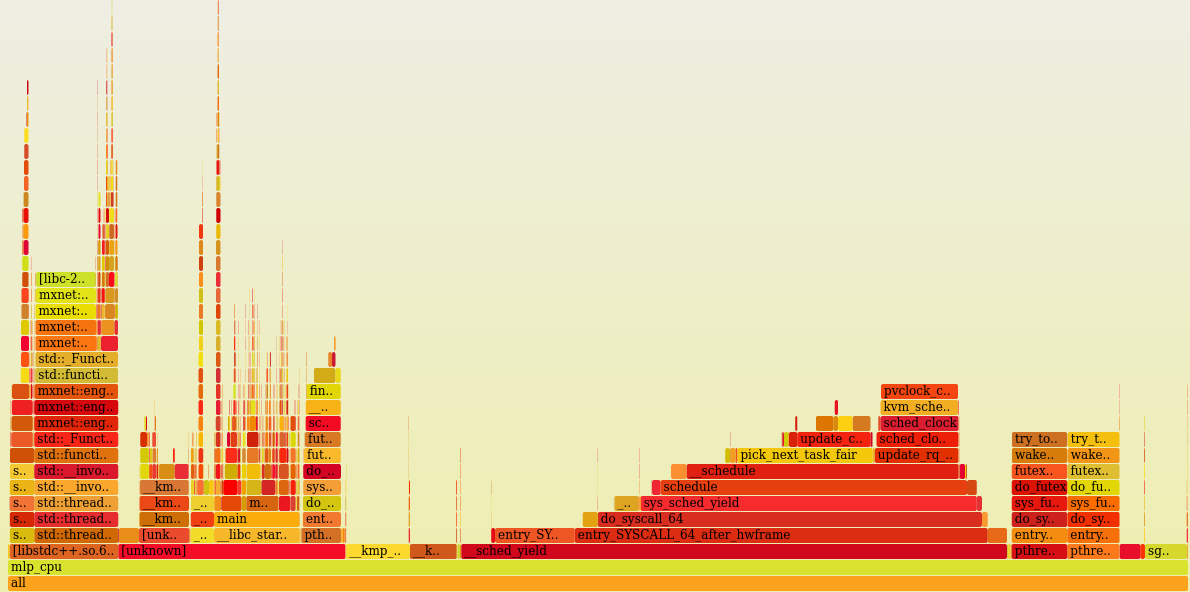In an earlier post, I had described
a couple of ways you could gain insight into debugging C++ applications. There
are several good tools to do something similar or better. However, this is
a method I prefer using since perf is ubiquitous and easy to work with.
In this post, I simply want to explore whether it is possible to debug and
profile Deep Learning Models in the same way that we generate perf stat and
other profiling info for the models. We will take a relatively simple example
and walk through it until we can get meaningful info/statistics from it.
MXNet is an open source Deep Learning library that is flexible and easy to understand. Real World DL Models can get very complex very fast with many hidden layers through which data is passed and compute heavy mathematical functions which are called often. These operators require significant optimizations or efficient implementations in the library.
Multi-Layer Perceptron
Below we will look at a sample code for creating a Network with multiple layers
that are full connected between each successive layers. The Activation function
at each layer is Relu and the final one is a softmax output. It can be
found under the examples section.
Setup
Deep Learning Framework: MXNet
MXNet provides support for multiple languages through it’s APIs. Python is
the lingua franca of the Deep Learning world, but it can be a little cumbersome
to use as a target language to obtain profiler information from. So I decided to
the C++ API for this exercise. I compiled MXNet for the C++ interface
which needs to be built separately from source. Intel's MKLDNN Math Library
was built from source and installed on the machine. In addition, MXNet was
explicitly pointed to use this in our case.
After building this, you get a binary that is executable like any other C++ application since the model is now linked to the MXNet’s version under C++.
Training Data: MNIST Data:
Since the samples mostly work with MNIST Dataset, we will download it and use it for training. http://data.mxnet.io/mxnet/data/mnist.zip
Symbol mlp(const std::vector<int> &layers) {
auto x = Symbol::Variable("X");
auto label = Symbol::Variable("label");
std::vector<Symbol> weights(layers.size());
std::vector<Symbol> biases(layers.size());
std::vector<Symbol> outputs(layers.size());
for (size_t i = 0; i < layers.size(); ++i) {
weights[i] = Symbol::Variable("w" + std::to_string(i));
biases[i] = Symbol::Variable("b" + std::to_string(i));
Symbol fc = FullyConnected(
i == 0? x : outputs[i-1], // data
weights[i],
biases[i],
layers[i]);
outputs[i] = i == layers.size()-1 ? fc : Activation(fc, ActivationActType::kRelu);
}
return SoftmaxOutput(outputs.back(), label);
}
Training Loop:
The training loop is simple enough to understand from the code and comments.
for (int iter = 0; iter < max_epoch; ++iter) {
int samples = 0;
train_iter.Reset();
// train_iter is a MNIST Data Set Iterator
auto tic = std::chrono::system_clock::now();
while (train_iter.Next()) {
samples += batch_size;
auto data_batch = train_iter.GetDataBatch();
// Set data and label
data_batch.data.CopyTo(&args["X"]);
data_batch.label.CopyTo(&args["label"]);
// Compute gradients
exec->Forward(true);
exec->Backward();
// Update parameters
for (size_t i = 0; i < arg_names.size(); ++i) {
if (arg_names[i] == "X" || arg_names[i] == "label") continue;
opt->Update(i, exec->arg_arrays[i], exec->grad_arrays[i]);
}
}
auto toc = std::chrono::system_clock::now();
Accuracy acc;
val_iter.Reset();
while (val_iter.Next()) {
auto data_batch = val_iter.GetDataBatch();
data_batch.data.CopyTo(&args["X"]);
data_batch.label.CopyTo(&args["label"]);
// Forward pass is enough as no gradient is needed when evaluating
exec->Forward(false);
acc.Update(data_batch.label, exec->outputs[0]);
}
float duration = std::chrono::duration_cast<std::chrono::milliseconds>
(toc - tic).count() / 1000.0;
LG << "Epoch: " << iter << " " << samples/duration << " samples/sec Accuracy: " << acc.Get();
}
Perf Output and Flamegraph:
Here it is.
A huge amount of time is spent in Data Iterator or handling page faults
resulting in using the data iterator. MKLDNN makes things much more
efficient. Almost all of them end up in jit_avx32_gemm_. The data loader
causes the thread to yield. The other important part of the Control Flow Graph
where a lot of time is spent is Threads
My Podcast!
If you like topics such as this then please consider subscribing to my podcast. I talk to some of the stalwarts in tech and ask them what their favorite productivity hacks are:
Available on iTunes Podcast
Visit Void Star Podcast’s page on iTunes Podcast Portal. Please Click ‘Subscribe’, leave a comment.


